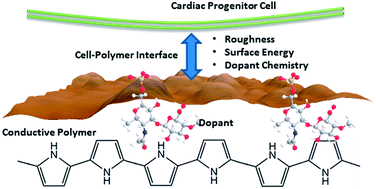Influence of conductive polymer doping on the viability of cardiac progenitor cells†
Abstract
Cardiac tissue engineering via the use of stem cells is the future for repairing impaired heart function that results from a myocardial infarction. Developing an optimised platform to support the stem cells is vital to realising this, and through utilising new ‘smart’ materials such as conductive polymers we can provide a multi-pronged approach to supporting and stimulating the stem cells via engineered surface properties, electrical, and electromechanical stimulation. Here we present a fundamental study on the viability of cardiac progenitor cells on conductive polymer surfaces, focusing on the impact of surface properties such as roughness, surface energy, and surface chemistry with variation of the polymer dopant molecules. The conductive polymer materials were shown to provide a viable support for both endothelial and cardiac progenitor cells, while the surface energy and roughness were observed to influence viability for both progenitor cell types. Characterising the interaction between the cardiac progenitor cells and the conductive polymer surface is a critical step towards optimising these materials for cardiac tissue regeneration, and this study will advance the limited knowledge on biomaterial surface interactions with cardiac cells.


 Please wait while we load your content...
Please wait while we load your content...